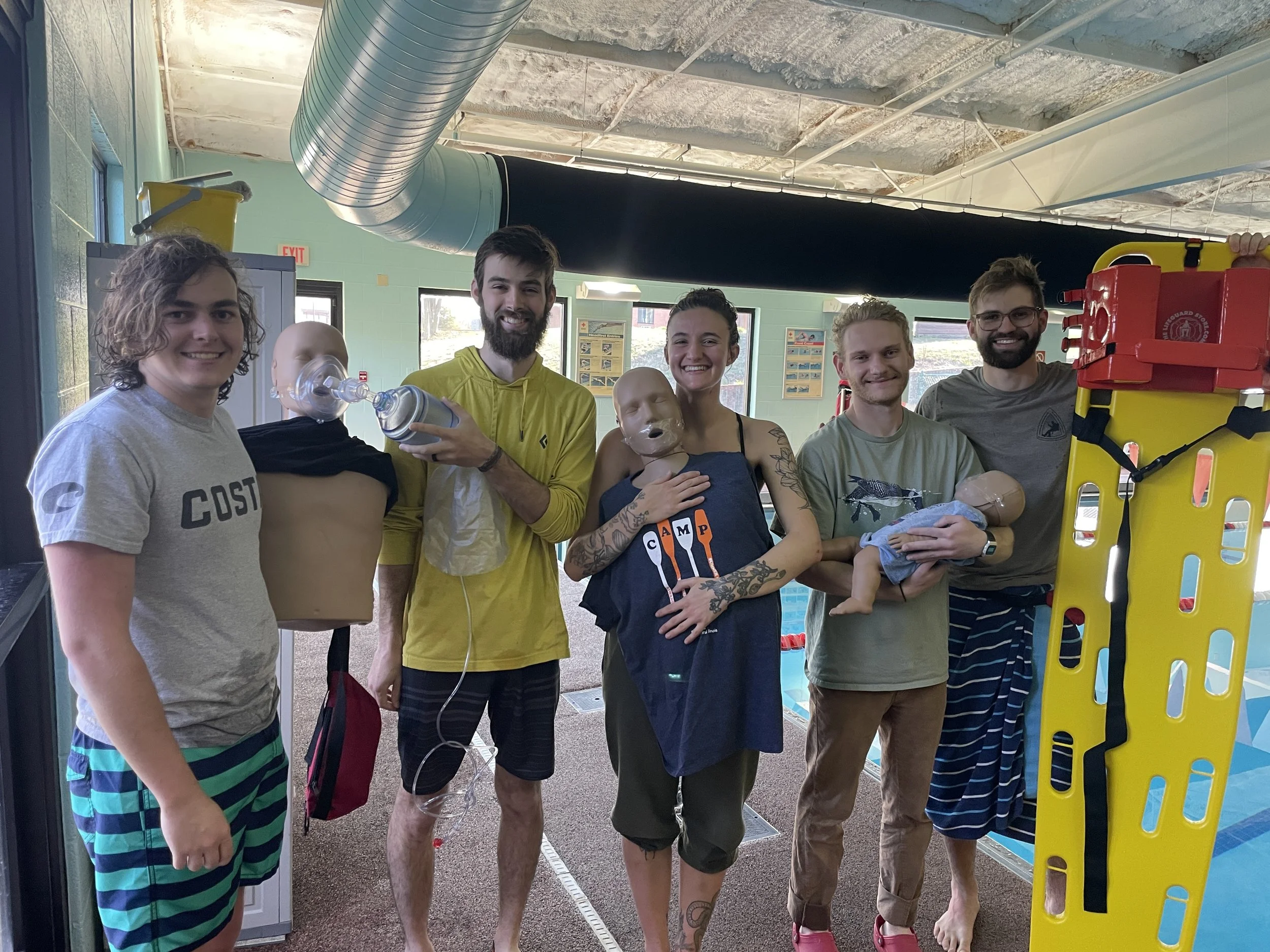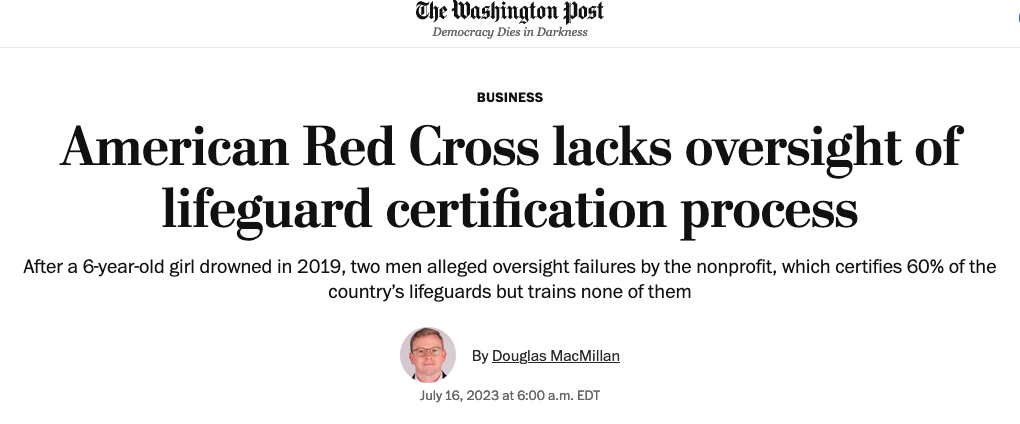The American Red Cross released a much-anticipated Lifeguarding curriculum update on February 6, 2024. After digging into the curriculum over the last month and leading several Lifeguarding Instructor courses, I have had a chance to process the new info and discuss with other camp leaders. This blog is designed to explain the updates and discuss how classes will operate with Ruby Outdoors this pre-season.
Course updates
Most of the actual lifeguarding curriculum is the same when it comes to rescues, extrications, and care. There should be no issue about guards trained under the previous curriculum (referred to as r.17) and the new curriculum (r.24) guarding alongside one another.
The new lifeguarding skills are as follows:
A modified passive-submerged rescue for water depths of 5’-7’
An increased focus in the class on scanning, surveillance, and rotations, including added time for practicing and a new final assessment testing students on scanning zones and rotating in and out of station
Something else that is new is the prerequisites have changed. The long swim and the tread have been combined into one prerequisite that must be completed continuously in a swim-tread-swim sequence. It is as follows:
Waterfront: Swim 350 yards, tread for 2 minutes without using your hands, swim 200 yards
Lifeguarding: Swim 150 yards, tread for 2 minutes without using your hands, swim 50 yards
For both of these, the swim must be conducted using the front crawl/freestyle stroke or breaststroke. For freestyle, there must be an out-of-water stroke recovery (no doggy paddling) For both strokes, students must swim using rhythmic breathing with their face in the water for the bulk of their swim. Students will also be required to enter the water by jumping in, completely submerging, resurfacing and beginning their swim and breaks at the wall/boundary are not allowed. Goggles may be worn during the swim-tread-swim prerequisite only and are not allowed at any other point in the prerequisites or class.
The timed response–aka the brick test–is the other prerequisite of the class and has not changed
There have also been some terminology updates. Here is a quick list of those:
Victim -> drawing person or injured/ill person
Spinal backboarding -> spinal motion restriction
Extrication at the pool edge -> rapid extrication
Primary assessment -> rapid assessment
The aforementioned are the student-facing, curriculum updates.
Admin Updates
Where the bulk of the updates have taken place is in course administration, the HOW of offering a lifeguarding course.
To sum these updates up, there was some amount of grace (and loose interpretations!) offered during COVID to simply make classes happen. Much of that grace is no longer possible with the r.24 update. The American Red Cross is also under an increasing amount of scrutiny after this headline appeared during summer 2023 in the Washington Post.
That scrutiny is trickling down to Licensed Training Providers like Ruby Outdoors so there are simply some practices that may have been done in the past that we cannot do anymore to stay compliant with the Ruby Outdoors agreement with the American Red Cross. To be able to continue offering training for camps and camp professionals, we have to all ensure we are meeting the requirements and guidelines going forward.
Those include the following…
All blended learning classes for Lifeguarding + Waterfront must be scheduled for at least three days for the in-person skills sessions including two 2.5-hour evening classroom sessions to ensure we meet the 27 hour instruction time minimum.
You can opt for a fully instructor-led course as scheduling allows. This will be a total of 32.5 hours. (27 hours 30 minutes for Lifeguarding + 5 hours for Waterfront). This will likely look like four 8-hour days, still with two evenings of classroom time. This 32.5 hour instruction time is a minimum and does not include meal breaks, transitions, and rest breaks.
All courses must have a lifeguard on surveillance duty during the in-water portions of the class. This cannot be a student in the class.
Host camps must provide a classroom space that has power and is sheltered from the weather (wind and rain) that is available for use throughout the duration of the class. Even with blended-learning, there are some mandatory videos that must be viewed during the in-person class. This is also critical for if bad weather strikes during the course.
Classes must have a minimum of 5 students. 6 is a preferred minimum. That means there must be at least 5 students who are able to pass the prerequisites and who can continue with the whole course.
If there are not 5 lifeguarding students, it is possible to continue the course with “Helpers” who are already certified in lifeguarding to assist as drowning people for skills practice and additional rescuers during the multiple-rescuer response scenarios and final assessments.
If after the prerequistes, your student numbers drop under 5, the course cannot proceed.
An instructor to student ratio of 1:10 must be maintained. As soon as your class has more than 10 people, a second instructor must be added to the course. If you are over 20 people, a third instructor must be added to the course.
When weather conditions are not conducive to extended time practicing skills in the water, additional time may need to be added to the course to keep students safe and warm.
So now what?
Here is what Ruby Outdoors is doing to assist with bringing camps into compliance of these regulations:
Providing detailed itineraries specifically prepared for each camp regarding the planned classroom and water times so lifeguards can be scheduled for surveillance duty
Adjusting schedules to accommodate the additional in-person time
Ruby Outdoors can provide the screens, projectors, and computers for showing videos OR utilize camp equipment as it is available
Offering a simultaneous shallow-water lifeguarding certification with less strenuous prerequisites and assessments for camps that have facilities that are conducive to also having shallow-water lifeguards
We are also looking at the possibility of hiring lifeguards to be available to guard during your classes if you are unable to meet that requirement. See pricing info below.
Lastly, with the update of the prerequisites, we are expecting a higher failure rate from students, particularly those that have had no recent practice swimming prior to their course. See this blog post for more information about the updated prerequisites and swim workouts you can distribute to your students to help set them up for a better chance of success.
Pricing
For some of you, you will see an increase in cost from previous years. In the spirit of transparent pricing, please see the info below:
1st instructor fee remains the same = $475/day (regardless of the length of the day beyond ~4 hours, anything less than 4 hours is charged at a ½ day rate)
2nd instructor fee = $300/day
3rd instructor fee = $250/day
Per certification issued / per person fee = $50 per student
American Camp Association-accredited camps get a 20% discount off this per person fee due to an MOU between the American Red Cross and the ACA
Lifeguard on duty, hired by Ruby Outdoors = $25/hour for in-water session time
FAQs
If I have an LGI on my staff, can they be the additional instructor?
Yes, if they are present for all skill sessions both on land and in-water. If they do not have reliable availability during the course, it likely will not work for them to be the second instructor. Where I see this as a problem is when the staff member is unable to shift their schedule around when weather dictates that the class schedule be shuffled.
You mentioned needing a minimum of 5 students and needing a lifeguard on duty. Can the lifeguard on duty also be an additional “helper” to meet the minimum of the class?
Maybe. It boils down to numbers. If your class has only 4-5 students, then yes, it will probably work for your lifeguard on duty to also be a “helper” because they will be needed to assist with the multiple-rescuer response scenarios. If your class has fewer than four students, then there are still additional helpers that are needed to meet the class minimum.
Why are there minimum student numbers?
During the class, lifeguarding students must practice team responses and those team responses require 4 trained-responders to complete the practice per American Red Cross training standards. Because the American Red Cross is a national provider of trainings and the expectation is that courses will be conducted similarly no matter where a student takes the course, there is no wiggle room on whether they participate in this multiple-rescuer response scenario, even if your facility does not ever have more than 1 or 2 guards on duty. National training programs carry the weight they do due to their training guidelines being standardized across the country
Why are you telling us these changes now? I’m feeling kind of stuck and without options for this summer.
I totally hear you on that. It is generally agreed that the r.24 curriculum being released in February was a short amount of time that organizations can adjust to the updated program for the upcoming summer. That said, I fully support the American Red Cross’ decision to go ahead and make the update available so we can better streamline our trainings and provide safer learning environments for our students.
If these new updates feel like they disqualify you from being able to host a training at your camp, please let me know and we can discuss what options may be available. That may include teaming up with another camp to offer training and split costs. It may mean looking at offering a less-intensive course if your aquatics facilities allow for it (see this blog post about shallow-water lifeguarding and this post about whether you need to have waterfront-certified guards at your facility or not). It may mean looking at other training providers at other nearby facilities who may be able to include the costs of these updates in their course cost already (think like an open-enrollment lifeguarding course at a local aquatics facility). I am also here and available to you to discuss the updates further if there are questions you have about what’s driving these changes.
If you want to get your own staff trained to run a lifeguarding course, I have one more Lifeguarding Instructor class on the calendar for May 6-8, 2024. It is $525 per person and there are still open spots in the class. If having your own LGI on staff is the best option for you but this May isn’t an option, I will also offer 2-4 LGI courses in the offseason of 2024-2025 in the Asheville area and can direct you to other providers in the southeast who offer this course as well.
In the end, we are all working to keep our facilities as safe as possible while mitigating a high-risk area at camp. Please let me know how I can support and how you want to proceed with your training this summer.




